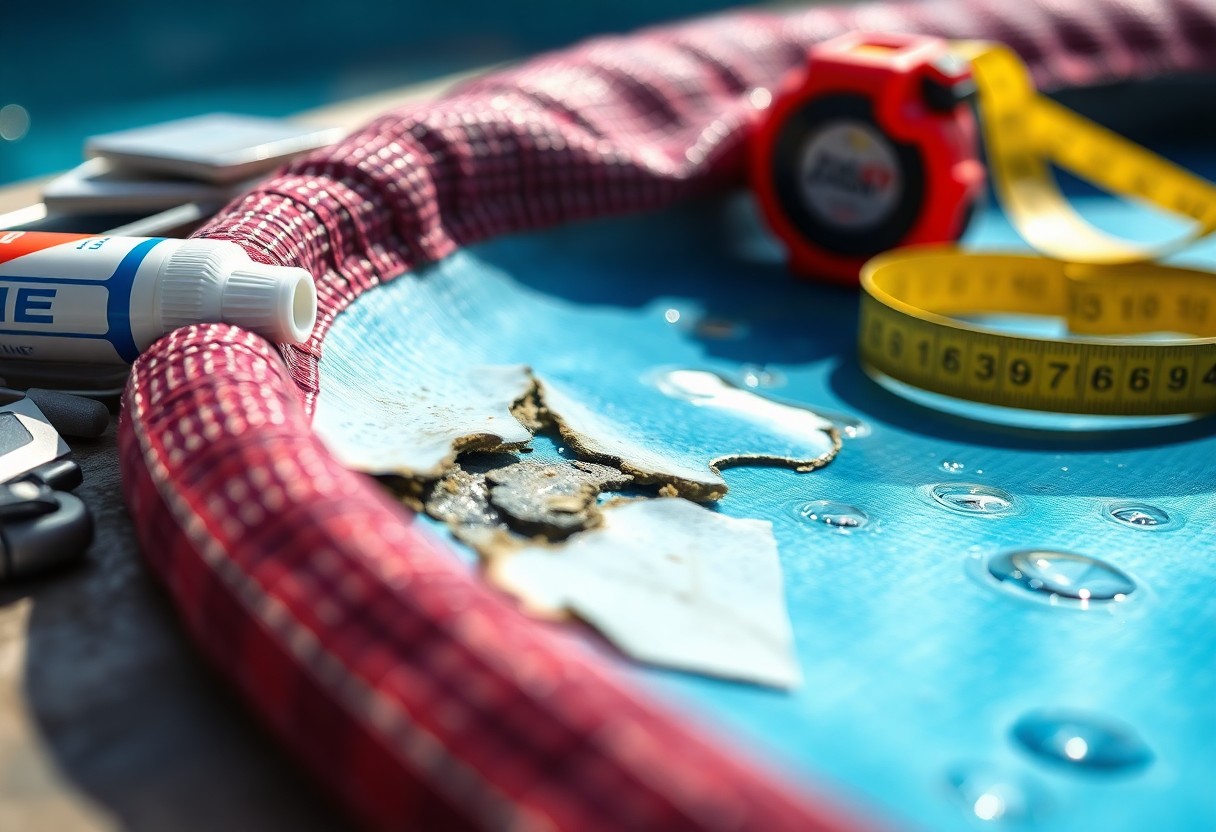Repairing a pool liner is an almost inevitable situation. Over time, your pool liner may develop defects that require attention. Understanding the various factors influencing repair costs can save you time and money. Key elements include the type of defect, the size of your pool, and the materials needed for repair. Additionally, labor costs and seasonal demand can also impact pricing. By being informed about these variables, you can better navigate the process of repairing your pool liner defect and ensure that your pool remains a safe and enjoyable haven.
Key Takeaways:
- The type and extent of the damage significantly affect repair costs, with larger or more complex tears requiring more resources and labor.
- Material quality and the specific type of pool liner, such as vinyl or fiberglass, can influence pricing, as different materials have distinct repair processes and costs.
- Labor costs can vary based on location and availability of skilled technicians, making the geographic area a key factor in overall repair expenses.
1. The size of the pool affects repair costs significantly. 2. The type of liner material influences expense greatly. 3. The severity of the defect determines repair complexity. 4. Local labor rates impact overall repair pricing. 5. Accessibility of the pool area can increase costs. 6. Additional repairs may be needed during the process.

Understanding Pool Liners
A pool liner is vital to your swimming pool, providing both aesthetics and functionality. It serves as a barrier that protects the pool structure and keeps water contained. Over time, wear and tear can lead to defects in the liner, requiring maintenance and repairing a pool liner to ensure your pool remains inviting and operational.
Types of Pool Liners
Understanding the different types of pool liners is vital at the heart of pool maintenance. Here are the most common types:
| Vinyl | It is affordable and customizable, but it can puncture easily. |
| Fiberglass | Durable and low maintenance, but more expensive. |
| Concrete | Long-lasting and customizable, requires more upkeep. |
| Tile | Elegant and customizable, but costs can be high. |
| Above Ground | Easy to install and less expensive; less durable. |
You should choose the liner type based on your budget and individual preferences.
Common Defects in Pool Liners
Defects in pool liners can significantly impact your pool’s functionality and aesthetics. Common issues include punctures, folds, and fading, which can detract from your pool experience.
With proper care, the life of your pool liner can be extended, preventing costly repairs. Punctures can lead to leaks, and fading can spoil your pool’s visual appeal. Addressing folds quickly can save you time and money in repairs. Vigilance in monitoring these defects will help you maintain your pool’s integrity and enjoyment throughout the swimming season.
Factors Influencing Repair Costs
It is important to be aware of various elements that impact the cost of repairing a pool liner defect. Key factors include:
- Type of defect
- Material of the liner
- Size and shape of the pool
- Labor costs
- Location and accessibility
Perceiving these factors will help you make an informed decision when assessing repair options.
Material of the Liner
To understand how the material of the liner affects repair costs, consider that different materials, such as vinyl, fiberglass, or polyethylene, possess varying levels of durability and price. Vinyl liners may be prone to tears, necessitating specific repair techniques, while fiberglass liners often require specialized tools and expertise for effective repairs.
Size and Shape of the Pool
Repair costs are also influenced by the size and shape of your pool.
However, the larger your pool, the more material you’ll need for repairs, which can significantly increase overall costs. Additionally, unique shapes such as freeform or irregular designs may require specialized techniques, demanding more time and labor, further elevating expenses. Always assess the dimensions of your pool before initiating repairs to ensure you’re prepared for the potential costs associated with its size and shape.
Labor and Professional Services
All factors surrounding labor and professional services can significantly impact the cost of repairing a pool liner defect. Whether you choose to hire a professional or tackle the repair yourself, the quality of service, the complexity of the repair, and the rates charged by local service providers all play a vital role in overall expenses.
Hiring Professionals vs. DIY
By opting for professional services for your pool liner repairs, you ensure that the job is completed correctly and efficiently. While DIY may save you money upfront, the risk of improper repair could lead to more extensive damage and higher costs in the long run.
Geographic Location Impact
For pool owners, your geographic location can greatly influence the cost of repairs. Labor rates, service availability, and regional demand for pool services vary significantly, impacting your overall repair expenses.
The impact of your geographic location on pool liner repair costs can be significant. In high-demand areas or regions with a shortage of qualified professionals, you may find higher labor rates that increase your repair bill. Conversely, in locations with more competition and a greater number of service providers, you might enjoy lower prices. Additionally, if you live in a region with harsh climate conditions, such as extreme heat or cold, this could also lead to more frequent repairs, further impacting your maintenance budget.
Timing and Seasonal Considerations
Unlike many home repairs, the timing of a pool liner repair can significantly influence the overall cost. Whether you choose to tackle the repair during the off-peak season or wait for the height of summer can result in varying expenses and availability of skilled labor. Seasonal considerations, such as the demand for services during spring and summer, may impact pricing and the speed at which you can schedule the necessary repairs.
Off-Peak vs. Peak Repair Seasons
Below, you’ll find that off-peak repair seasons often come with lower labor rates and more available contractors. Planning your repair in late fall or early spring can not only save you money but also ensure that you receive better service due to reduced demand. Here, you may find that companies are more willing to negotiate on prices, making it the ideal time for repairs.
Weather Implications
Considerations regarding weather can also greatly impact the cost and timing of your pool liner repairs. Adverse weather conditions can delay repairs, potentially leading to increased costs due to prolonged exposure to the elements.
Even moderate temperatures and wet conditions can cause complications during the repair process, as many materials require dry conditions for optimal adhesion and longevity. Additionally, severe weather events like storms and intense heat waves can hinder your contractor’s ability to work efficiently, increasing labor costs due to last-minute scheduling changes. Keeping an eye on the forecast and planning accordingly is vital for ensuring that your pool liner repair is completed without unnecessary delays or expenses.
Additional Repair Needs
Despite the primary concern of repairing a pool liner defect, other repair needs can arise during the process. Repairing a liner might expose underlying issues, including damaged plumbing or equipment malfunctions. These additional repairs can significantly impact the total cost of your project. For a comprehensive overview of potential costs, check out What to Expect: Average Costs of Pool Liners Explained.
Related Repairs
Before starting the repair of your pool liner, evaluate any related repairs that may need attention. Issues with the pump, filter, or heater can contribute to liner damage and may need to be resolved simultaneously to avoid future problems.
Preventative Maintenance Costs
On the other hand, investing in preventative maintenance can save you money in the long run. Regular checks can help identify minor issues before they escalate into costly repairs, prolonging the life of your pool liner and equipment.
And by scheduling consistent preventative maintenance, such as cleaning and inspecting your pool, you can significantly reduce your chances of facing major issues. Essential checks, such as monitoring water chemistry and checking equipment functions, can prevent devastating damage that may require expensive repairs. Additionally, you enhance your swimming experience and ensure a safe environment for your family and friends.
Cost Breakdown
Not all pool liner repairs are created equal, and understanding the cost breakdown can help you anticipate your expenses. Various factors like materials, labor, and overall accessibility can significantly influence the final price. By being informed about each component of the repair process, you can make strategic decisions that fit your budget while ensuring a long-lasting solution.
Material Costs
To accurately estimate your repair costs, you must first consider the material costs. These costs generally depend on the type of pool liner you choose, whether it’s vinyl, fiberglass, or PVC. Additionally, the quality and thickness of the liner will affect pricing. You want to invest in durable materials that offer a good balance between affordability and longevity.
Labor Costs
Costs associated with labor can vary depending on the expertise and efficiency of the hired professionals.
Further, you should be aware that hiring experienced technicians can lead to faster and more reliable results, potentially saving you money in the long run. However, overcharging can occur with less reputable services, so it’s best to get multiple quotes before making a decision. Keep in mind that investing in skilled labor often means enhanced quality and peace of mind for your pool’s longevity and overall appearance.
Conclusion
On the whole, understanding the factors that influence the cost of repairing a pool liner defect can help you make informed decisions about your pool maintenance. Key aspects include the type of liner, the extent of the damage, and labor fees in your area. By assessing these factors, you can optimize your repair strategy and potentially save money. For more insights on related costs, check out The Cost of Neglecting Your Pool: Repair Service and ….
Q: What types of pool liner defects can impact repair costs?
A: Various types of pool liner defects can significantly influence the cost of repairs. Common defects include tears, punctures, and wrinkles. Small punctures are typically less expensive to fix, often requiring simple patching. In contrast, larger tears or significant wrinkles may necessitate replacing sections of the liner, which can drive up costs considerably. Additionally, issues such as water intrusion behind the liner or misalignment can complicate repairs, leading to increased labor time and material costs.
Q: How do the materials used in pool liners affect the cost of repairs?
A: The materials from which pool liners are made play a vital role in determining repair costs. Vinyl liners, for instance, are generally less expensive to repair compared to fiberglass or tile surfaces. Replacement parts for vinyl liners are usually readily available and cost-effective, while repairs on fiberglass liners may involve more specialized materials and labor, thus increasing expenses. Furthermore, the thickness and quality of the liner material can also affect durability and repairability, potentially influencing overall repair costs.
Q: What additional factors can increase the overall cost of repairing a pool liner defect?
A: Besides the type and material of the liner, several other factors can increase the repair costs. Labor rates vary by region, meaning that hiring professionals in areas with a higher cost of living can add to the overall expense. Seasonal demand also plays a role; during peak pool season, contractors may charge more due to increased workloads. Additionally, if the repair requires draining the pool or if landscaping or decking needs to be disturbed, this can lead to further costs associated with those services, ultimately escalating the total expense of repairing the pool liner defect.
